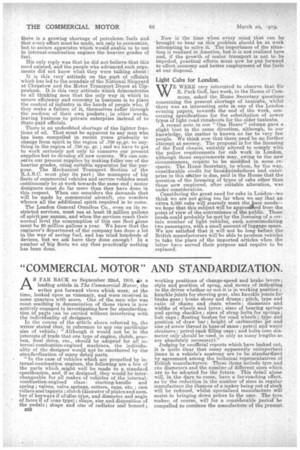"COMMERCIAL MOTOR" AND STANDARDIZATION.
Page 2

Page 3

If you've noticed an error in this article please click here to report it so we can fix it.
AS FAR BACK as September. 22nd, 1910, an. a leading article in The Commercial Motor, the writer put forward views which were, at the time, looked upon as visionary, and were received in some quarters with scorn. One of the men who was most scathing in denunciation of those views is now actively engaged in investigating how far standardization of pants can be carried without interfering with the individuality of designers.
In the course of the article above referred to, the writer stated that, in reference to any one particular size of vehicle: " Although it would not be in the interests of trade that one type of engine, clutch, gearbox, final drive, etc., should be adopted for all internal-combustion-engined machines, the individuality of the designer would not be smothered by the standardization of many detail parts. • "In the ease of vehicles which are propelled by in
ternal-combustion engines, the following are a few of the parts which might well be Made to a standard specification, and, if so designed, they would be interchangeable for all makes of vehicles of the internalcombustion-engined class: starting-handle and spring ; valves, valve springs, cotters, caps, etc. ; cant rollers and tappets ; clutch (diameter of plates and limber of keyways if of -szlise type, and diameter and angle of faces if of cone type) ; shape, size and disposition of the pedals ; shape and size of radiator and bonnet ;
working positions of change-speed and brake levers ; style and position of sprag, and means of indicating to the driver whether or not it is in working position ; knuckle joints for steering gear, also knuckle joints for brake gear ; brake shoes and drums ; pitch, type and ratio of chains and chain wheels ; diameters andwidths of wheels and tyres • sizes of bearing springs and spring shackles ; sizes Of strap bolts for springs; hub caps ; floating bushes for road wheels ; type and position of draw bar ; height of carburetter jet and size of screw thread in base of same ; petrol and water strainers ; petrol-tank filling caps ; and bolts (one diameter only should be used, in only as many lengths as are absolutely necessary)."
Judging by unofficial reports which have leaked out, it is quite clear that many apparently unimportant items in a vehicle's anatomy are to be standardized by agreement among the technical representatives of British manufacturers. These items include tyre and rim diameters and the number of different sizes which are to be adopted for the future. This detail alone will, in the days to come, have a far-reaching effect, as by the reduefien in the number of sizes in regular manufacture the chances of a maker being out of stock will be reduced, whilst specialized manufacture will assist in bringing down prices to the user. The tyre maker, of course, will for a considerable period be compelled to continue the manufacture of the present
full range of sizes, hut, as motor manufacturers have now pledged themselves not to incorporate any nonstandard site of tyres in future designs, the time will ultimately arrive when the new standards will have full effect.
It may be many years before that day arrives, but a start must be made somewhere, and the Association of British Motor and Allied Manufacturers, who, in collaboration with the British Rubber Tyre Manufacturers' Association and the gritish Engineering Standards Association have undertaken this work, are to be congratulated upon making a serious start in the important matter.
Other items which are being standardized are grease clips, lubricators, petrol and other forms of stop cocks, control levers, carburetter fittings, water pipe rubber connectors, clips, locking washers, castellated shafts, screw threads and gauges, frame dimensions, as affecting bodywork, and a host of other parts, the ultimate effect of their general adoption being to remove much worry from the shoulders of owners, and enable them to keep their vehicles in regular service by the ease of obtaining replacements. Too often an owner must keep a vehicle out of use pending the receipt from the manufaeturer of some small part such as are new to be standardized, whereas, in the near future, an owner will be able to purchase standardized parts from any dealer in components in addition to the particular maker of his vehicle. Any parts agreed upon in this way by the Standardization Committee would be manufactured in large quantities in one or more works, and supplied to the various motor builders, instead of each maker producing his own,
Important as the question of standardization is to the British motor manufacturer, there is an even more important matter remaining to be dealt with and that is the conducting of useful and well-considered research work. British-built commercial vehicles now lead, but that lead cannot be maintained without serious effort, not the effort of any one firm, but the united efforts of all British motor vehicle builders. No one individual or firm can afford to carry research so far as it is desirable' and, even if they could, they would naturally desire to profit by the result of their investigations before communicating the findings to the trade in general. Combination, for research purposes' therefore, is obviously the best way, and 3udging by the recent publication of notices relating to the formation of a Research Association, as announced in The Commercial Motor of the 26th ultimo, the incorporation of such an organization is now practically complete. This new body, "The Research Association of the British Motor and Allied Manufacturers," is the outcome of deliberations of the Association of British Motor and Allied Manufacturers, and, it is to be hoped, it will have all the success its objects deserve.






















